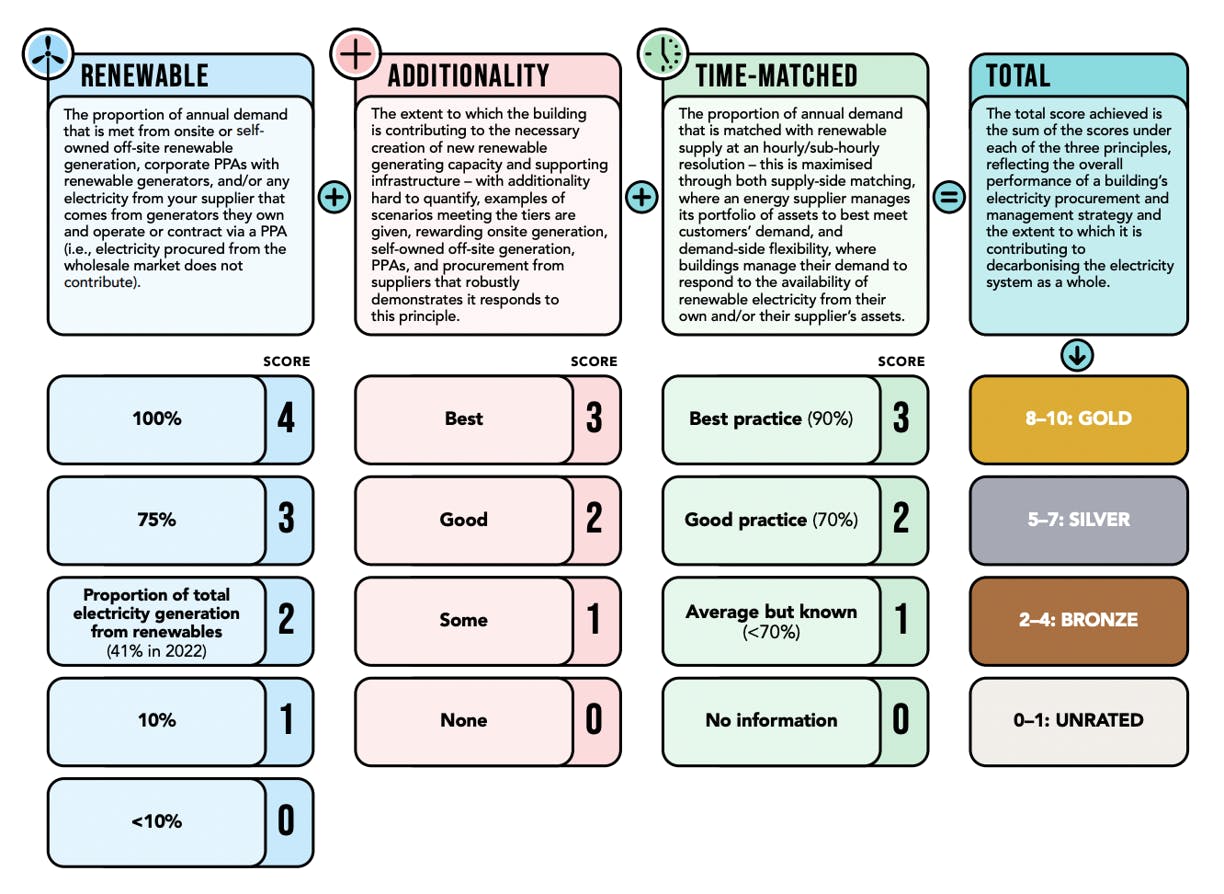Insight · 6 February 2024
Hourly Matching Myths
There are understandably lots of questions when it comes to matching your electricity consumption with clean energy on an hour by hour basis. This article seeks to address some of the misconceptions that we often hear.

Today, the vast majority of green electricity tariffs and green energy claims by consumers are based on ‘annual matching’ of electricity consumption with clean energy production. As interest in temporal matching grows (also known an ‘hourly matching’ or ‘24/7 clean energy’), there are understandably questions being raised about the potential increase in complexity and costs of this new way to buy electricity. This is especially true since the US Treasury’s recently proposed hourly-matching requirement for the green hydrogen tax-credit. This article provides a few ‘myth-busting’ facts about hourly-matching.
Hourly-matching requires moving from 100% matching of clean energy on an annual basis to 100% matching every single hour: FALSE
A common misconception is that hourly-matching means going straight from being matched 100% annually to being matched 100% every single hour. The term ‘24/7 clean energy’ is perhaps slightly confusing as it implies there is a need to match consumption with clean energy in all hours. This is not the case; the first and most important step is to begin measuring the overall level of matching between your consumption and clean energy generation on an hourly or sub-hourly basis – this is also known as the CFE (carbon free energy) score.
Anyone who buys clean energy on a 100% annual basis, already has a certain level of hourly matching, they are just unaware of what this level is. Ask your energy provider to give you transparency on when your electricity is coming from clean sources and when it isn’t (we can help here). Once you have this information you can gradually start to improve your level of hourly matching, for instance through ‘demand response’ or additional purchases.
Studies have shown that even if just a small share of businesses achieve hourly matching scores of 90%, this can lead to meaningful growth in new grid-decarbonisation technologies without adding significant costs.
Companies like Google have set roadmaps to reach 100% hourly matching in 2030, from a lower starting point today. Recent green energy procurement standards such as the UK Green Building Council’s (see below), highlight the benefit of measuring the level of time-matching, setting its highest tier at only 90% matching or above. Indeed, 70% hourly matching is a more transparent and realistic declaration, likely to last the test of time, rather than 100% annual which is not telling whole story. Transparency is key.
Moreover, starting to measure the level of hourly matching will incentivise eliminating the remaining fossil fuels in their electricity supply.

UK GBC's framework for clean procurement
Hourly matching is expensive: FALSE
Getting started with hourly-matching does not need to be any more expensive than annual matching of clean energy. Studies from Princeton and TU Berlin show that the cost of hourly matching is relatively small, increasing significantly only above 90% matching.
Once you have received a measure of your level of hourly matching, there are various ways you can improve your CFE score at no cost. Shifting your consumption to times of day when there is more renewable energy available (e.g. through demand response) will help improve your CFE score and could even lead to lower overall electricity costs.
Today, significant amounts are spent on renewable energy certificates for annual matching ($10bn in 2022 expected to rise to over $100bn by 2030). Shifting to hourly-matching would direct this spending toward technologies that deliver clean energy at the times it is in short supply, rather than rewarding clean energy generation when it is already in over-supply. Hourly matching can be a powerful price signal for grid decarbonization – without requiring further expenditure than is already forecast.
Hourly matching is complicated and only for large businesses: FALSE
We strongly believe that hourly matching should be as easy for energy consumers as signing up to a green tariff from an energy company. Just as they navigate the complexity of wholesale power markets on behalf of consumers, utilities and other specialist energy companies are well placed to manage the complexity of hourly matching of clean energy. At Granular Energy we are helping energy providers create green tariffs incorporating hourly matching, enhancing the green offers they have today. So from a customer’s perspective, it’s as easy as subscribing to any other type of energy supply contract meaning that small businesses or even residential customers can now source clean energy on an hour-by-hour basis (for examples, see our recent work with utilities Good Energy, LichtBlick or SSE).

Hourly matching does not reduce carbon emissions: FALSE
Some have questioned whether hourly matching has a real-world impact on reducing carbon emissions. Recent research shows that hourly matching can lead to real emissions reductions of 84 to 120%.
Just by starting to measure and then gradually increase levels of hourly matching, consumers can send important price signals that drive deployment of needed technologies such as energy storage, or drive changes in behaviour that facilitate grid decarbonisation (e.g. demand response).
Consumers may not be able to claim a direct causal link between their actions and the construction of a new energy project (which is challenging under any circumstances), however they can send an important demand signal which is likely to lead to an overall increase in green supply (see our blog post on additionality here).
Hourly matching is more confusing than annual matching: FALSE
Hourly matching is more intuitive than annual matching because it links electrical energy that is produced and consumed at the same time. Annual matching enables electricity generation to be ‘matched’ with consumption at any point in a 12-month window, which implies solar energy produced in the daytime can be consumed at night-time – not very intuitive!
Furthermore, in today’s energy market, there are two separate and disconnected systems; i) the wholesale electricity market which is an hourly-matching system but with no transparency on the source of energy and ii) the Energy Attribute Certificate (EAC) system which provides transparency but is based on annual matching. Having two unaligned systems creates unnecessary complexity and confusion because certificates can be purchased independently from the wholesale power. Moving to granular certificates and hourly matching creates alignment between these two disparate systems (see our whitepaper on this topic with the power market operator NordPool).
Hourly matching requires changes in regulation: FALSE
There are several regulatory changes that would help to accelerate widespread adoption of hourly matching by consumers, but there are things consumers can start doing today.
The main types of regulation changes that would be helpful are:
- Regulations that accelerate the availability of time-stamped certificates. Most certificates that are issued today tell you where the electricity came from, but not when it was produced. Increasingly the issuers of energy attribute certificates (normally grid operators or regulators) are starting to develop the capability to issue timestamped energy certificates. This includes most of the large certificate registries in the US, and in September 2023 the EU’s latest Renewable Energy Directive specified that Member States should make timestamped certificates available to those that want to use them.
- Regulations or standards that require the use of hourly matching for certain applications. We’ve seen the EU, UK and US require hourly matching for green hydrogen production from the end of the decade, and would welcome the expansion of these requirements to other sectors.
Neither of the two types of regulations required above prevent the uptake of hourly matching on a voluntary basis. Thanks to EnergyTag, the international standards body for timestamped energy certificates, a voluntary framework exists for hourly-matching of clean energy without risk of double counting and that is compatible with existing established EAC systems.
Share article
More insights
Company · 09.12.2025
Granular Energy approved as ESNA by Elexon
Granular Energy has been formally approved as an Exempt Supply Notification Agent (ESNA) by Elexon, following our Participant Approval Board meeting on 27 November 2025.
News · 09.12.2025
Carbon-Free Chronicles November 2025: The essential round up of news and reports relating to hourly transparency
As we enter the final month of the year, momentum behind granular energy tracking continues to build across markets, policy frameworks, and corporate climate strategies. November brought major updates from regulators, early insights into Scope 2 reforms, and important developments in certificate markets. We’ve also had a busy month at Granular. From new blog releases to an industry award win. Below is a roundup of the most relevant news shaping clean energy procurement and granular certificates.